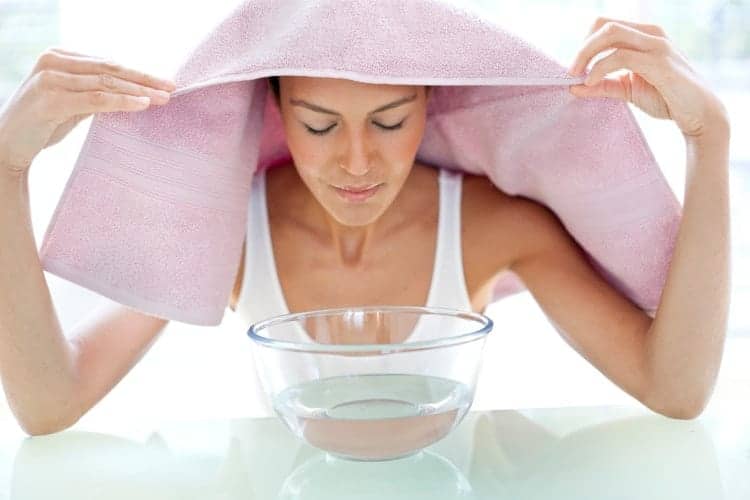
Whether you do it at a spa or at home, facial steaming can leave you looking and feeling pampered. But with so many other things already in our skin care routines, is steaming really necessary, and if it is, where does it fit in? Well this post answers that for you as we look at what to do before and after steaming your face.
To start off we’re going to talk about who steaming is for and who should avoid it. Then we’re going to dive into:
- how to steam your face at home.
- prepping your face for steaming.
- what to do after your facial steam.

| Before facial steaming | After facial steaming |
|---|---|
| Remove makeup | Use a gentle, non-abrasive scrub (optional) |
| Wash your face (optional) | Apply a face mask (optional) |
| Use a toner to balance skin’s pH (optional) | |
| Apply a serum and/or moisturizer |
Note: this post contains affiliate links and I earn a commission (at no additional cost to you) if you use them to make a purchase.
WHAT TO DO BEFORE A FACIAL STEAM
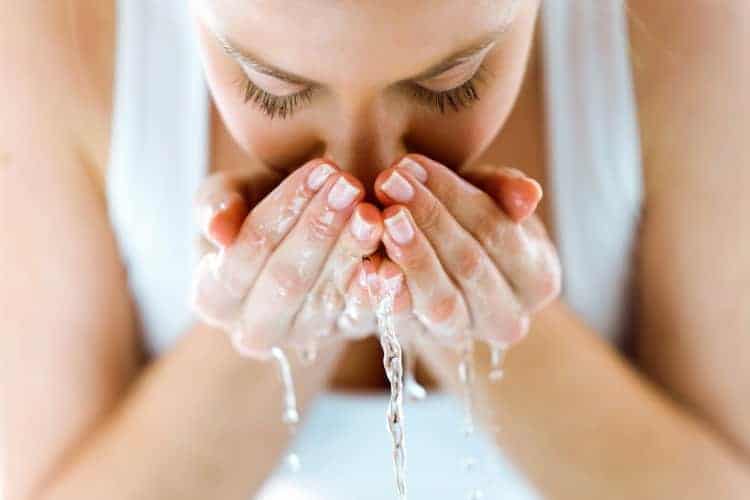
The first and only thing to do before a facial steam is to clean your face. This can mean doing one or both of the following:
- using a makeup remover.
- cleansing your face with a soap-free cleanser, gentle natural soap or a DIY cleanser (such as a honey face wash).
It goes without saying that if you wear makeup, then at a minimum, you should use a makeup remover.
Now, if you don’t wear makeup, here are a few things to consider:
- You have dry skin and/or live in a very dry climate: you might be better off skipping this entire step (yep, no cleansing whatsoever).
- You have very oily skin: you might want to wash your face just to get rid of excess oil on the face.
Other than making sure that you don’t have any makeup on, the rest really depends on your skin type. So, a little experimentation is necessary to find what works for you.
Once you’re done with step, you’re ready to steam your skin using your preferred method i.e. face steaming machine or a DIY steamer (more details about these coming up later).
WHAT TO DO AFTER STEAMING YOUR FACE
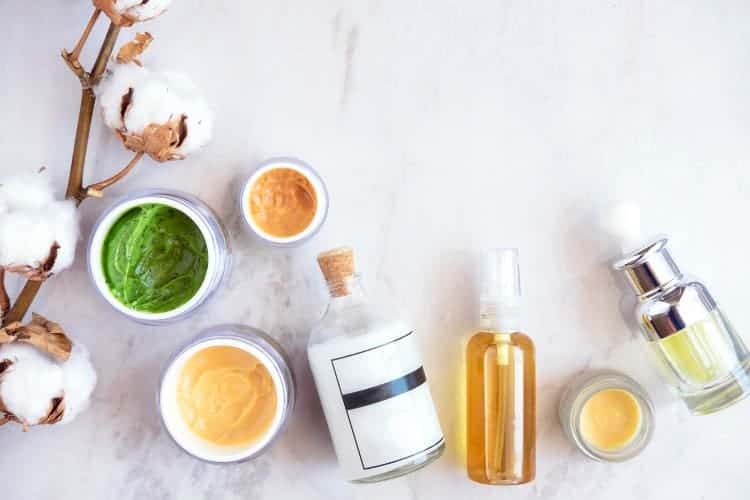
There are 5 things that you can do after steaming your face, depending on what works best for your skin. Below are those five things, listed in the order in which they should be done.
1. Gentle Exfoliation (optional)
Although some people like to scrub or exfoliate before steaming, you’ll get better results if you exfoliate after steaming.
This is because dirt and impurities are loosened up during steaming. Therefore the scrub is better able to remove all of that gunk afterward.
However, do be careful about the type of scrub you choose to use. Since your skin is very supple, a rough sugar or salt scrub will be quite irritating.
Instead go for something that is less physically abrasive, like oat flour (simply combine oat flour with water to form a paste). Or better yet, use a chemical exfoliator such as alpha hydroxy acids. These can be store-bought or homemade (goat’s milk is one of my favorites because it contains lactic acid!).
2. Apply A Mask (optional)
Now that your skin is a clean slate, this is the perfect time to apply a soothing face mask. Once again, the type of mask you use depends on what your skin needs. For example you can use a:
- Clay mask if you have oily and acne-prone skin.
- Sheet mask if you want to give your skin some extra hydration and nourishment.
- Cream mask if your skin is very dry and parched.
- Exfoliating mask if you want to lift off dead skin cells through the use of ingredients like alpha hydroxy acids.
For recipes and tips related to masks, check out this collection of homemade face masks to use after steaming.
3. Use A Toner (optional)
Toners provide multiple benefits, such as balancing the skin’s pH and in some cases, serving as an astringent (i.e. drying out oil and tightening pores).
However, as helpful as all of that may sound, they’re not always for everyone. Toners are definitely optional in many people’s skin care routines. So, feel free to skip this step if you know that toners simply don’t play well with your skin.
However, if you do decide to try a toner after steaming, then some of the best ones to use are plant hydrosols, such as rosewater or peppermint water.
They’re more gentle than alcohol-based toners which can be too irritating right after steaming.
4. Finish off With A Serum and/or Moisturizer
The final step to complete your post-steaming routine, is moisturization. This can be done by first applying your favorite serum (such as a vitamin C serum) and then topping that off with a regular moisturizer.
Or, if you don’t use serums, then simply apply your moisturizer of choice and you’re good to go!
Either way, a good moisturizer is a must, be it a lotion, cream or natural oil (like almond or jojoba oil) to lock in moisture.
IS IT BAD TO STEAM YOUR FACE?
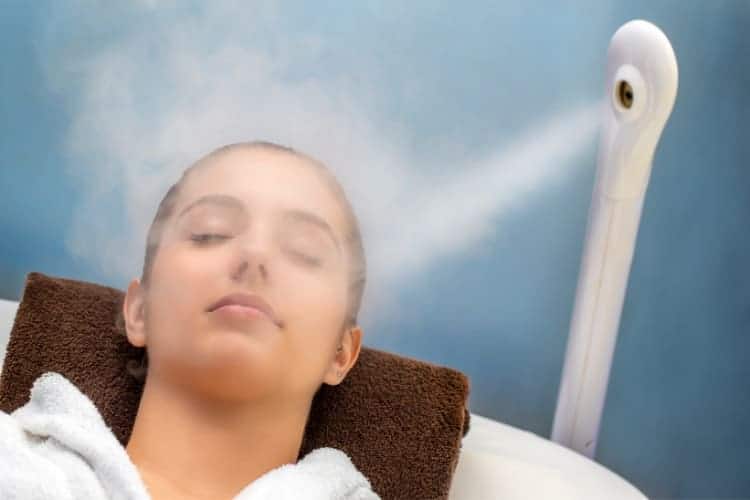
When done safely and correctly, steaming can help to improve conditions like acne, as well as the overall appearance of the skin. However, for people with very sensitive skin, or skin that is prone to redness (such as rosacea patients), the heat from the steam can actually aggravate redness and inflammation. In addition, for anyone with very dry skin or eczema, steaming can strip off too much oil, causing more irritation.
So, based on the above, steaming is better suited for oily skin mainly. If that’s you, then are some of the key benefits that steaming provides.
- Hydration: because steam is just water in a gaseous form, it helps to naturally hydrate the skin and keep it supple.
- Enhances absorption: the heat from steam softens the top layer of skin, thereby making the skin more receptive to whatever you apply onto it. So, this means it’s much easier for products to penetrate the skin. As a bonus, this can also enhance the effectiveness of those products.
- Releases trapped dirt and microbes: steaming helps lift off dead skin cells while also releasing excess sebum, bacteria and other impurities.
- Softens blackheads: one reason why aestheticians include facial steaming in their process is because it preps the skin for blackhead extraction (it’s easier to work with supple skin).
- Increases circulation: applying heat to any part of the body increases circulation. And the same happens to the face when exposed to steam – blood vessels dilate and blood flow increases (carrying with it all the nutrients that your skin needs for a healthy glow).
HOW CAN I STEAM MY FACE AT HOME?
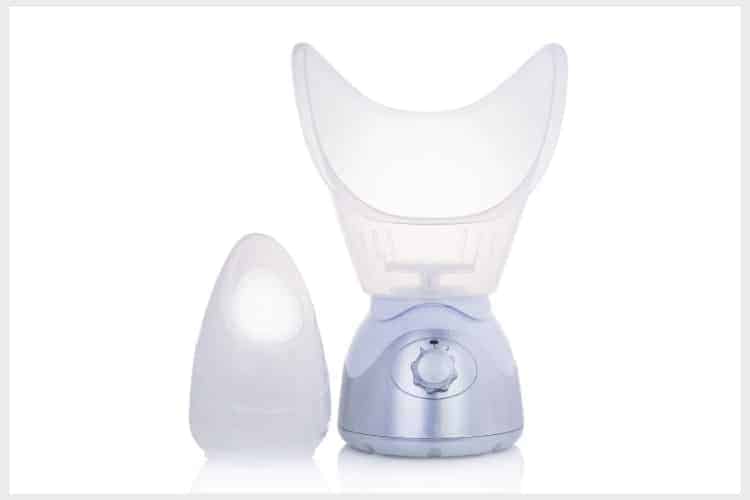
The two main ways to steam your face at home is with a store-bought steaming machine or with a DIY steamer.
1. Facial Steaming Machine
A facial steaming machine offers a spa treatment in the comfort of your home.
These machines are pretty straightforward and easy to use: there’s a water tank that you fill up with water and then the steam is released through a nozzle. Pretty easy.
When using a facial steamer, it’s generally recommended to sit with your face about 8 to 12 inches away from the steam.
In addition, you can place a towel over your head if you want to trap in more of the heat.
Now as far as where to find them, facial steamers are available from various online retailers.
If you’re new to steaming, then check out this nanosteamer machine from Pure Daily Care. It includes a blemish extractor kit as well as a towel-warming chamber (for a quick facial refresher!).
2. DIY Face Steamer
If you don’t feel like buying a facial steamer, you can simply use any medium to large-sized glass or ceramic bowl to hold the water. Please exercise a lot of caution with this method because you’re handling boiling water.
Here are the basic steps to follow when using bowl for steaming:
- Fill a medium sized pot, saucepan or kettle with water. For the best results, use distilled or filtered water so that you don’t get any of the impurities from tap water.
- Bring the water to a boil and remove from the heat.
- Place a large glass or ceramic bowl (no plastic) on top of a folded towel or a cork mat.
- Pour the boiling water into the bowl.
- Sit down with your face over the bowl, about 8 to 12 inches away.
- Drape a towel over your head so that it creates a tent to help trap in the heat. If this feels too intense and you’re not able to breathe comfortably then remove the towel.
- Close your eyes and stay here for 5 to 10 minutes.
- You can enhance your steaming session with herbs like calendula, comfrey or chamomile. Use this guide to learn how to use herbs for face steaming.
HOW LONG SHOULD I STEAM MY FACE?
5 to 10 minutes of steaming is enough for your face to get all the benefits. Avoid going longer than 10 minutes because your skin can get overheated, become dried out or red.
Remember that the steam dilates your blood vessels and that rush of blood to the skin can turn against you if you steam for too long.
In addition, overexposure to high temperatures and hot water can dry out the skin. So, yet another reason not to overdo it.
Lastly, if you’re brand new to facial steaming, it’s good idea to check your skin after about 3 minutes to make sure that there’s no sign of irritation from the heat. If everything looks good, you can keep going up to the 10-minute mark.
CAN YOU STEAM YOUR FACE EVERY DAY?
Facial steaming should only be done once a week to get the most out of it. Even though steaming hydrates the skin, too much of it will have the opposite effect. So, the goal is to strike the right balance.
As with all good things, too much can create problems. Also, remember that this is an intense treatment and therefore, it should be done sparingly.
RELATED QUESTIONS ABOUT WHAT TO DO BEFORE AND AFTER STEAMING YOUR FACE
Does steaming help acne scars?
Since steaming helps bring more blood (and therefore, nutrients) to the skin, in theory it can play a role in fading acne scars. However, this benefit only comes into play if you’re eating a nutrient-rich diet that supports healthy skin. Also, the effect of steaming on acne scars is most likely very minimal since some people never steam their face and they’re still able to get rid of the scars.
How can I open my pores without steaming?
While steaming doesn’t technically open the pores, it softens the topmost layer of skin. To get the same benefit without steaming you can do a “quick steam” using a face towel. To do this, simply:
- soak a face towel in very hot water.
- squeeze out the water and then press the towel onto your face.
- when you notice the towel getting cool, soak it in more hot water.
- repeat the process several times for about 5 minutes.
CONCLUSION
Steaming is a facial treatment that is usually done by skin care specialists like aestheticians. However, you can easily get the benefits from the comfort of your home by using a steaming machine or pouring hot water into a heat-safe bowl.
As with any skincare treatment, it’s important not to do overdo steaming. Once a week is ideal. Also, do make sure to clean your face prior to steaming, and then follow up with a scrub and/or mask. Lastly, don’t forget to use a soothing moisturizer as your final step.
Lastly, please note that you can boost the pampering effects of face steaming by using add-ins like herbs, essential oils or fruit peels. To learn more about how to do this, read this article on what to add to a facial steam. It outlines everything for you.
I hope this guide helped to clarify the whole process of facial steaming!
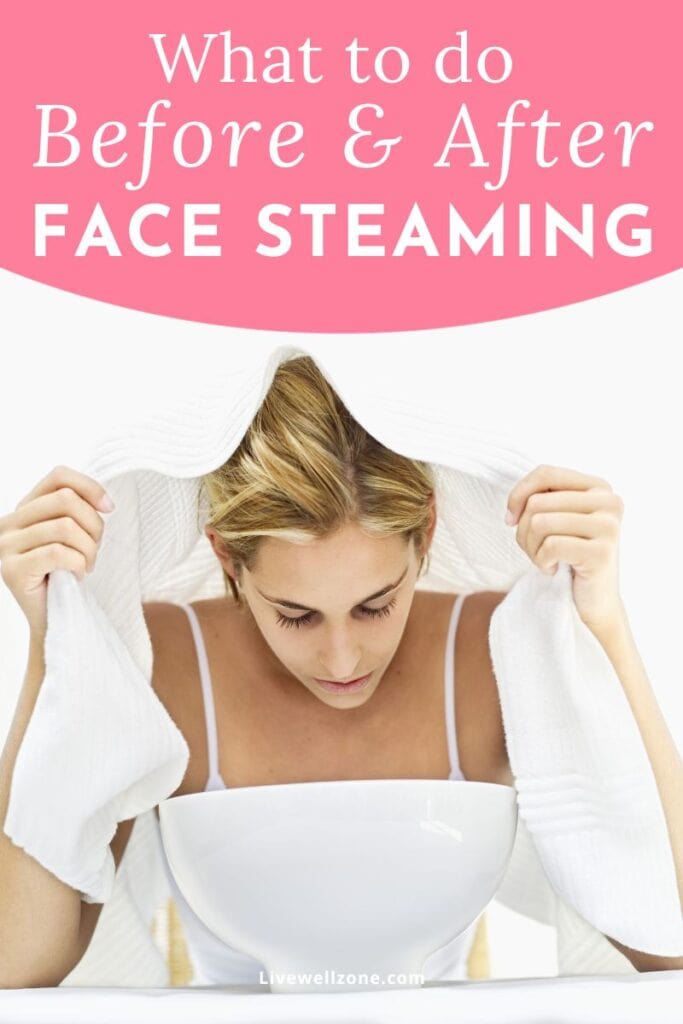
You Might Also Enjoy:
Which Is Better: Face Scrub Or Face Mask? Pros, Cons, How and When To Use
How to Double Cleanse: The Ultimate Guide
The Difference Between Rose Water and Micellar Water: A Complete Guide
What To Do Before and After Using A Clay Mask On Face: Step by Step Guide
Honey Mask vs Clay Mask: Benefits, How To Use and Recipes
Peppermint Tea vs Spearmint Tea for Acne: Which Is Better?
Vitamin C Serum vs Rosehip Oil: Benefits, Which Is Better and How To Use
Best Vitamin C Serum For Sensitive Skin: 7 Products to Transform Your Skin
11 Best Oils for Under Eyes (to Improve Wrinkles, Puffiness, Dark Circles and Dryness)
Green Tea vs Matcha for Skin: Similarities, Differences and How to Use Them for Clear Skin
Carrier Oils By Skin Type: How to Choose and Simple List for Beginners

